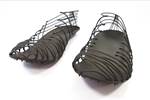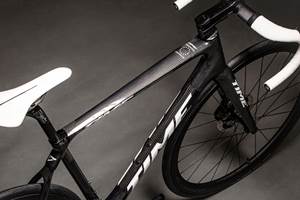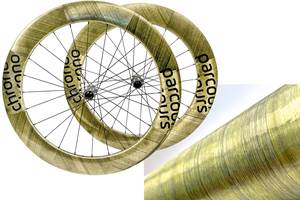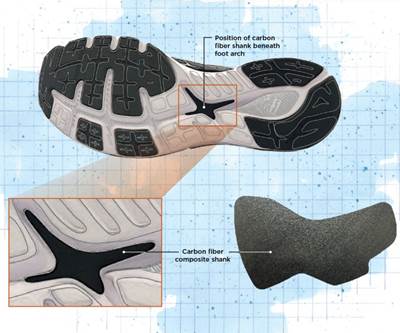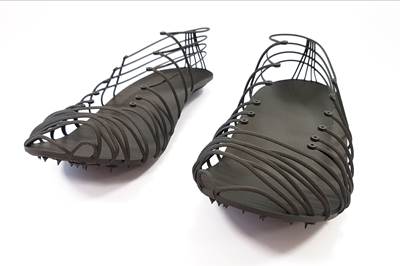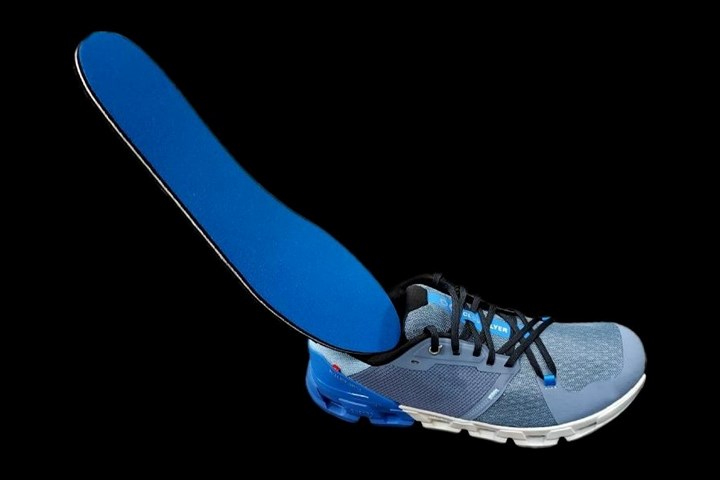
The most recent product from composite sporting goods developer FlexiStiX LLC is a line of running shoe inserts featuring a layer of unidirectional (UD) continuous glass fiber-reinforced thermoplastic material (shown above as the white layer underneath a layer of blue neoprene) to increase runner comfort, stride length and speed. Photo Credit: FlexiStiX LLC
There are typically three layers to the soles of running shoes: a durable exterior outsole, a midsole that takes most of the impact and an insole that has the most direct contact with the foot.
Aiming to make the lightest weight, highest durability athletic shoes available, there have been a number of carbon fiber composite midsoles and other shoe components on the market for years. Generally targeted at elite athletes, these carbon fiber composite-enhanced shoes offer runners top-tier stride and speed increases.
However, carbon fiber is also very rigid, which can have negative effects on the runner’s feet, legs and muscles, explains Gordon Brown, president of sporting goods developer Flexi-StiX LLC (Anderson, S.C., U.S.). He contends that for the average runner, fiberglass is a better, more flexible, more forgiving material option for increasing performance in running shoes by providing smoother, continuous energy return to the runner’s foot.
Brown has extended his career and expertise in the composites industry into several athletic training inventions, including the Jump Sticks athletic training device, which uses pultruded fiberglass rods within a PVC tube to produce a semi-flexible but resistant dynamic training device.
He has long had an interest in composites for high-performance running shoes, and over the years has worked on various prototypes and patents alongside Jeff Milliman, former professional runner, master shoe designer and operator of athletics store Greenville Running Co. (Greenville, S.C., U.S.).
Milliman himself has spent decades working on and evolving composites in running shoes, creating his own custom shoes to compete with as well as those for customers. He has long thought that fiberglass was the ideal material option for running shoes, noting its flexibility and versatility.
“They’re comfortable, the wearer feels less fatigue and they make the shoe last longer. There’s a lot of potential.”
Brown and Milliman have recently developed and commercialized their latest innovation, a patent-pending running shoe insole made from unidirectional (UD), continuous fiberglass-reinforced thermoplastic tape sandwiched between two layers of neoprene foam.
These latest insoles are the result of several decades of development in this field. In the 1990s, Brown and Milliman began by prototyping continuous fiberglass/epoxy midsoles for running shoes, targeting maximum cushioning and a spring-like effect that returned energy to the runner. These midsoles, roughly shaped like two sinusoidal waves on top of each other, were wet laid in an aluminum mold, pressed and oven cured.
“These midsoles worked — they were flexible, they lengthened the stride, they produced a spring effect,” Brown says, “but they were labor-intensive and ultimately not commercially viable.” The team decided to switch to fiberglass composite insoles, aiming to provide cost-effective benefits to the consumer without redesigning an entire shoe.
The first insole design involved the layup of tiny pultruded fiberglass/epoxy rods in stripes along the width of the insole. These were placed in a way that enabled them to bend in the middle, allowing a smooth, dynamic rolling motion that lengthened the stride with a more moderate spring-like effect. “This design was also successful in practice, but also labor-intensive to manufacture,” Brown says.
In the last few years, he notes that the development and increased availability of UD thermoplastic tapes “has been a gamechanger.” The gamechanging nature of the materials is two-fold, he explains. First, the UD and continuous orientation of the fibers, if aligned across the width of the shoe the way the original pultruded fiberglass rod design did, can be directed in such a way that lengthens the runner’s stride. “With running shoes, it’s all about increasing forward motion,” Milliman says. As the runner presses down on the insoles with the foot, a regular neoprene insole absorbs the energy that is exerted, but a fiberglass composite insole deflects the energy back to the runner, giving a more controlled spring effect and lengthening the stride. Brown emphasizes, “The fiberglass returns energy.”
Second, the use of a thermoplastic instead of a thermoset resin enables a reduced modulus, which makes the insole more comfortable for the wearer and also helps the insole conform to the foot. “The heat from the foot warms the thermoplastic just slightly, just enough so that it can form into the shape of the foot,” Brown says.
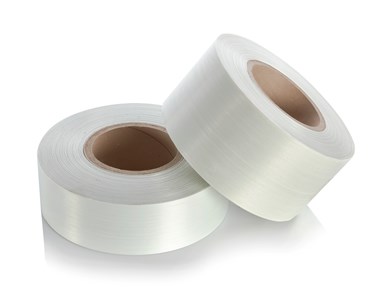
Avient Corp.’s Polystrand continuous fiber-reinforced thermoplastic tape material is layered between Neoprene sheets of different stiffness and thickness levels. Photo Credit: Avient Corp.
After working on several prototypes by hand, Brown and Milliman collaborated with material partner Avient Corp. (Avon Lake, Ohio, U.S.) to produce sheets of sandwich materials consisting of three plies — one layer of Polystrand UD fiberglass/thermoplastic tape in between two layers of neoprene foam. These sheets are then die-cut into insoles matching a range of shoe sizes, and can either replace existing shoe insoles or be placed beneath the existing insole. Two different thicknesses (5 or 8 millimeters) are available depending on the customer’s desired cushioning.
Marketed as FlexSpring insoles, runner trials over the past year have demonstrated successful results. Users experienced a longer stride length and an increase in number of strides per minute (also known as a runner’s cadence), enabling them to run faster and beat personal records. “You also get a better recovery time, less fatigue and there’s not as much rotation from side to side — not as much supination or pronation, in other words,” Milliman says. “Plus, they’re durable, allowing running shoes to last up to three times as long by reducing the compression on the midsole material.”
FlexSpring insoles are now available at Milliman’s Greenville Running Co. store. In future, Brown says their goal is to partner with a running shoe manufacturer to build FlexSpring insoles directly into the midsole of the shoe.
Beyond running shoes, the insoles could also ultimately be used in other types of performance footwear, Brown adds, such as basketball shoes and work shoes such as those worn by assembly line workers. “They’re comfortable, the wearer feels less fatigue and they make the shoe last longer. There’s a lot of potential.”
Related Content
Time Bicycles to modernize composite bicycle manufacturing
With the aid of KraussMaffei, Clemson University and SC Fraunhofer USA Alliance, Time anticipates a transition to HP-RTM for more efficient carbon fiber bike frame manufacture, plus a new facility in South Carolina.
Read MoreCarbon Mobile carbon fiber powers handheld gaming platform
HyRECM technology effectively stabilizes carbon fiber’s electrical and antenna properties, enabling development of next-gen electronics, such as the Snapdragon G3x Gen 2.
Read MoreMito Materials graphene amplify composite fly fishing rod performance
Functionalized graphene addition to premium-performance Evos and Evos Salt fly rods by St. Croix Fly enables faster recovery, increased torsional rigidity and improved strength-to-weight ratios.
Read MoreColored carbon fiber composite bike wheels launched at The Cycle Show
Wheel brand Parcours reveals composite bike wheels using Hypetex colored carbon fiber to achieve aesthetic, lightweight and performance goals.
Read MoreRead Next
Tuning the running shoe
Continuous fiber-reinforced thermoplastic composites enable high-performance athletic shoe components.
Read MoreCarbon fiber, additive manufacturing enhance Pleko spike shoe performance
Developed with 3D scanning support from Diadora and CRP Technology’s Windform SP carbon fiber-filled composite material and 3D printing process for a track shoe that meets individuals’ needs in terms of foot structure and athletic performance.
Read MoreDeckers Innovation Lab combines fast, casual comfort with composite footwear
The KO-Z Sport Low Wool Carbon footwear features an Xponent midsole with carbon fiber plate layered between upcycled EVA foam for a “fast-casual” shoe selection.
Read More

.jpg;width=70;height=70;mode=crop)

